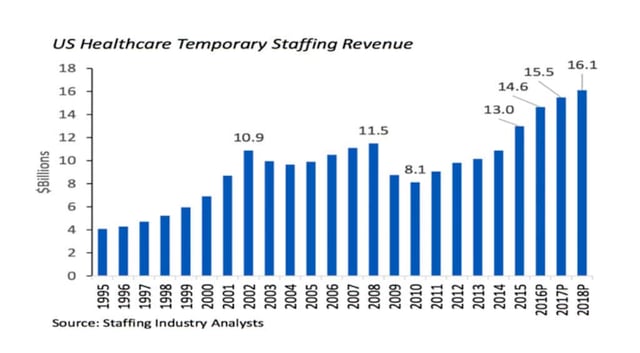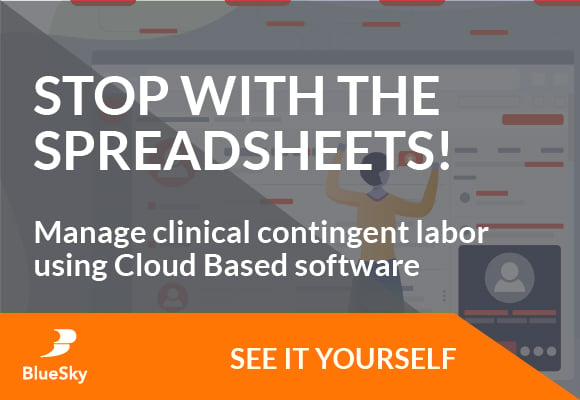More Access To Talent
As a growing number of Millennials enter the workforce, the decision to work independent of a structured workweek is making contracted labor more and more attractive. Millennials have now surpassed the baby boomers and are expected to comprise 47% of the workforce by 2020 (Pew Research Center). As demand for healthcare workers continues to remain intense, hospitals using the same outdated models of recruitment could encounter a shrinking pool of candidates.
Changing Technology Requires Changing Business Models
For decades, hospitals have attempted to model in-house pools to reduce the need for overtime and agency labor. Many HR departments say they are decreasing or even eliminating contract labor. Apparently this initiative is not indicative of the industry based on the chart below.
This trend should come as no surprise. According to a recent survey, 60% of Millennials say they are open to "different" job opportunities. Whether this means a different career, or a different way of handling their existing career, hospitals should take note. Technology is enabling and propelling what Millennials will now consider normal. If the degree of technological change is not forefront in the minds of HR manager, they may be missing out. Consider the first time a Baby Boomer could text and had a full size keyboard on their phone, they were already in their 40's.
Resistance To Change
Except for the serious downturn in the economy just before and after 2009, the temporary staffing industry in healthcare has flourished. Simply put, there is a growing number of candidates choosing temporary assignments outside the historic framework of direct hospital employment. It is not uncommon to show unpleasant budget results in overtime and contract labor spend. As the old adage goes, “Keep doing the same thing you’re doing, and you will keep getting the same result.” It is time to embrace change and get creative.
Question The Supply Side - Not The Demand
Whenever demand exceeds supply, speed to market and innovative strategies will win the day. In such a competitive environment, new strategies are needed to decrease vacancy rates and better manage costs. For most hospitals, demand is a given. By utilizing modeling algorithms, census fluctuation can be more accurately predicted over blocks of time. It can be noted that aging baby boomers are already starting to heavily impact future census projections. If current strategies are falling short, will they be enough in the future? Current laudable efforts consider workplace culture, flexible work schedules, scholarships, and close ties with many nursing institutions. These actions have certainly helped, but fail to address one of the top issues facing hospitals: increased choices by younger nurses which do not include full time hospital employment.
To increase access to the universe of contracted nurse labor, hospitals have resorted to Managed Services Providers (MSP’s) that act as a funnel to aggregate dozens of staffing agencies to provide a larger selection of talent in a single portal. The purpose of this arrangement is to maximize “fill rate” and reduce the expense of dealing with multiple agencies. It would be instructive to carefully review actual fill rates and satisfaction both before and after the institution of a MSP aggregator. Prior to the growth of the MSP model, the database of talent was behind a wall of protection via the agency/hospital contract. The newer MSP model has further distanced candidates via a contract between hospital and MSP, and an additional contract between agency and MSP.
Is It Time For Change?
Just as cell phones and text messaging have grown exponentially, staffing technology has also advanced. Managing multiple agencies and a myriad of candidates is no longer the complexity it once was. Bill rates, credentials, and time and attendance are no longer labor-intensive tasks requiring significant manual entry. Hospitals that take back the reigns of control with new technology will find an entirely new database of candidates and can move back to “transparent and direct” access to candidates from agencies. Multiple agencies, quality candidates, and billing are now aggregated for the hospital within a single software platform which hospital staff can use effectively. Time savings and cost savings may mean it's time for change.
The Race Is On
Whenever demand exceeds supply, speed to market and innovative strategies will win the day. In such a competitive environment, new strategies are needed to decrease vacancy rates and better manage costs.





